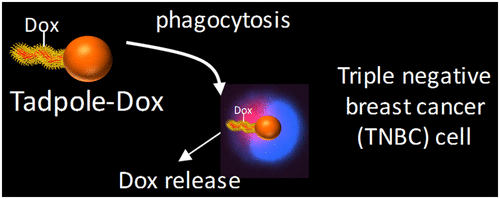当前位置:
X-MOL 学术
›
Biomacromolecules
›
论文详情
Our official English website, www.x-mol.net, welcomes your feedback! (Note: you will need to create a separate account there.)
Therapeutic Delivery of Polymeric Tadpole Nanostructures with High Selectivity to Triple Negative Breast Cancer Cells.
Biomacromolecules ( IF 6.2 ) Pub Date : 2020-03-26 , DOI: 10.1021/acs.biomac.0c00302 Valentin A Bobrin 1 , Yanling Lin 1 , Jianwei He 1, 2 , Yan Qi 1, 3 , Wenyi Gu 1 , Michael J Monteiro 1
Biomacromolecules ( IF 6.2 ) Pub Date : 2020-03-26 , DOI: 10.1021/acs.biomac.0c00302 Valentin A Bobrin 1 , Yanling Lin 1 , Jianwei He 1, 2 , Yan Qi 1, 3 , Wenyi Gu 1 , Michael J Monteiro 1
Affiliation

|
Targeted delivery of therapeutic drugs using nanoparticles to the highly aggressive triple negative breast cancer cells has the potential to reduce side effects and drug resistance. Cell entry into triple negative cells can be enhanced by incorporating cell binding receptor molecules on the surface of the nanoparticles to enhance receptor-mediated entry pathways, including clatherin or caveolae endocytosis. However, for highly aggressive cancer cells, these pathways may not be effective, with the more rapid and high volume uptake from macropinocytosis or phagocytosis being significantly more advantageous. Here we show, in the absence of attached cell binding receptor molecules, that asymmetric polymer tadpole nanostructure coated with a thermoresponsive poly(N-isopropylacrylamide) polymer with approximately 50% of this polymer in a globular conformation resulted in both high selectivity and rapid uptake into the triple breast cancer cell line MDA-MB-231. We found that the poly(N-isopropylacrylamide) surface coating in combination with the tadpole’s unique shape had an almost 15-fold increase in cell uptake compared to spherical particles with the same polymer coating, and that the mode of entry was most likely through phagocytosis. Delivery of the tadpole attached with doxorubicin (a prodrug, which can be released at pHs < 6) showed a remarkable 10-fold decrease in the IC50 compared to free doxorubicin. It was further observed that cell death was primarily through late apoptosis, which may allow further protection from the body’s own immune system. Our results demonstrate that by tuning the chemical composition, polymer conformation and using an asymmetric-shaped nanoparticle, both selectivity and effective delivery and release of therapeutics can be achieved, and such insights will allow the design of nanoparticles for optimal cancer outcomes.
中文翻译:

对三阴性乳腺癌细胞具有高选择性的聚合物Ta纳米结构的治疗性递送。
使用纳米颗粒靶向治疗药物向高度侵袭性三阴性乳腺癌细胞的靶向递送具有降低副作用和耐药性的潜力。可通过将细胞结合受体分子掺入纳米颗粒表面以增强受体介导的进入途径(包括clathein或小窝内吞作用)来增强细胞进入三阴性细胞的进入。然而,对于高度侵袭性的癌细胞,这些途径可能无效,而来自巨胞饮或吞噬作用的更快更大量的摄取明显更有利。在这里,我们表明,在没有附着细胞结合受体分子的情况下,涂有热响应性聚(N-异丙基丙烯酰胺)聚合物与大约50%的这种聚合物呈球状构象,从而导致高选择性并迅速被三元乳腺癌细胞系MDA-MB-231吸收。我们发现,与具有相同聚合物涂层的球形颗粒相比,聚(N-异丙基丙烯酰胺)表面涂层与the的独特形状相结合的细胞摄取几乎增加了15倍,并且进入方式最可能是通过吞噬作用。附有阿霉素(一种前药,可在pH <6下释放)的the的递送显示IC 50明显降低了10倍与游离阿霉素相比。进一步观察到,细胞死亡主要是通过晚期凋亡引起的,这可能允许进一步保护免受人体自身免疫系统的侵害。我们的结果表明,通过调节化学成分,聚合物构象并使用不对称形状的纳米颗粒,可以实现选择性以及有效的治疗药物递送和释放,而这种见识将使纳米颗粒的设计可实现最佳的癌症治疗效果。
更新日期:2020-03-26
中文翻译:

对三阴性乳腺癌细胞具有高选择性的聚合物Ta纳米结构的治疗性递送。
使用纳米颗粒靶向治疗药物向高度侵袭性三阴性乳腺癌细胞的靶向递送具有降低副作用和耐药性的潜力。可通过将细胞结合受体分子掺入纳米颗粒表面以增强受体介导的进入途径(包括clathein或小窝内吞作用)来增强细胞进入三阴性细胞的进入。然而,对于高度侵袭性的癌细胞,这些途径可能无效,而来自巨胞饮或吞噬作用的更快更大量的摄取明显更有利。在这里,我们表明,在没有附着细胞结合受体分子的情况下,涂有热响应性聚(N-异丙基丙烯酰胺)聚合物与大约50%的这种聚合物呈球状构象,从而导致高选择性并迅速被三元乳腺癌细胞系MDA-MB-231吸收。我们发现,与具有相同聚合物涂层的球形颗粒相比,聚(N-异丙基丙烯酰胺)表面涂层与the的独特形状相结合的细胞摄取几乎增加了15倍,并且进入方式最可能是通过吞噬作用。附有阿霉素(一种前药,可在pH <6下释放)的the的递送显示IC 50明显降低了10倍与游离阿霉素相比。进一步观察到,细胞死亡主要是通过晚期凋亡引起的,这可能允许进一步保护免受人体自身免疫系统的侵害。我们的结果表明,通过调节化学成分,聚合物构象并使用不对称形状的纳米颗粒,可以实现选择性以及有效的治疗药物递送和释放,而这种见识将使纳米颗粒的设计可实现最佳的癌症治疗效果。



























 京公网安备 11010802027423号
京公网安备 11010802027423号